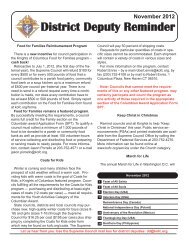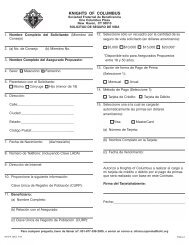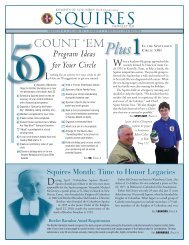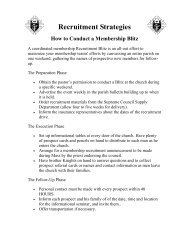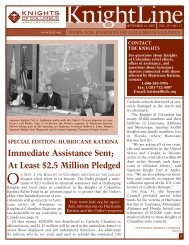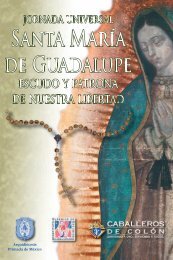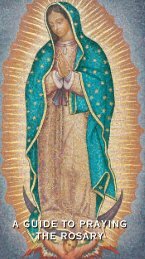Dating - Knights of Columbus, Supreme Council
Dating - Knights of Columbus, Supreme Council
Dating - Knights of Columbus, Supreme Council
You also want an ePaper? Increase the reach of your titles
YUMPU automatically turns print PDFs into web optimized ePapers that Google loves.
endnotes<br />
_______________________<br />
1<br />
This history is based on Mary Ann Schwartz & Barbara Marliene Scott, “<strong>Dating</strong>,<br />
Coupling, and Mate Selection,” Marriages and Families: Diversity and Change, Fifth<br />
Edition (Upper Saddle River, NJ: Prentice Hall, 2007).<br />
2<br />
Pope Benedict XVI, Deus Caritas Est (2005).<br />
3<br />
Joshua Harris, I Kissed <strong>Dating</strong> Goodbye (Colorado Springs: Multnomah, 2003).<br />
4<br />
Cfr. Schwartz & Scott’s Marriages and Families, 158-161.<br />
5<br />
Pope John Paul II, On the Dignity and Vocation <strong>of</strong> Women (1988).<br />
6<br />
Paul VI, Humanae Vitae, n. 12: “This particular doctrine, <strong>of</strong>ten expounded by the<br />
Magisterium <strong>of</strong> the Church, is based on the inseparable connection, established by<br />
God, which man on his own initiative may not break, between the unitive significance<br />
and the procreative significance which are both inherent to the marriage act.<br />
“The reason is that the fundamental nature <strong>of</strong> the marriage act, while uniting<br />
husband and wife in the closest intimacy, also renders them capable <strong>of</strong> generating new<br />
life—and this as a result <strong>of</strong> laws written into the actual nature <strong>of</strong> man and <strong>of</strong> woman.<br />
And if each <strong>of</strong> these essential qualities, the unitive and the procreative, is preserved, the<br />
use <strong>of</strong> marriage fully retains its sense <strong>of</strong> true mutual love and its ordination to the<br />
supreme responsibility <strong>of</strong> parenthood to which man is called. We believe that our<br />
contemporaries are particularly capable <strong>of</strong> seeing that this teaching is in harmony with<br />
human reason.”<br />
7<br />
This description <strong>of</strong> “practice” is derived from Alasdair MacIntyre’s definition in After<br />
Virtue (Notre Dame: University <strong>of</strong> Notre Dame Press, 1984), 187.<br />
8<br />
“Evidently, eros needs to be disciplined and purified if it is to provide not just fleeting<br />
pleasure, but a certain foretaste <strong>of</strong> the pinnacle <strong>of</strong> our existence, <strong>of</strong> that beatitude for<br />
which our whole being yearns.<br />
“Two things emerge clearly from this rapid overview <strong>of</strong> the concept <strong>of</strong> eros past and<br />
present. First, there is a certain relationship between love and the Divine: love promises<br />
infinity, eternity—a reality far greater and totally other than our everyday existence. Yet<br />
we have also seen that the way to attain this goal is not simply by submitting to instinct.<br />
Purification and growth in maturity are called for; and these also pass through the path<br />
<strong>of</strong> renunciation. Far from rejecting or “poisoning” eros, they heal it and restore its true<br />
grandeur.” Pope Benedict XVI, Deus Caritas Est (2005), 4-5.<br />
9<br />
Stanley Hauerwas, Stanley Hauerwas: A Reader, eds. John Berkman and Michael<br />
Cartwright (Durham: Duke University Press, 2001), 524.<br />
-31-




